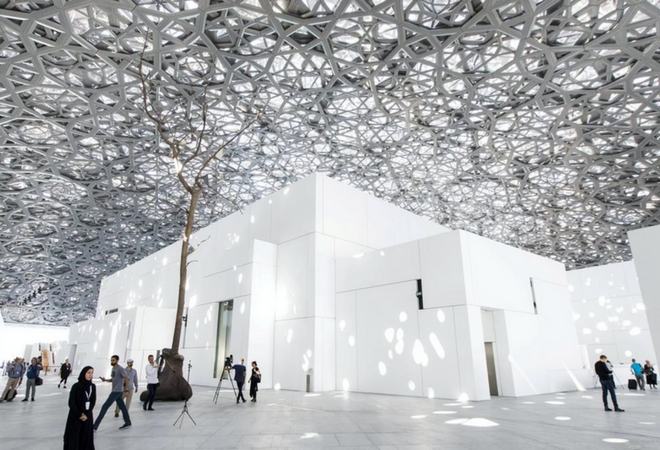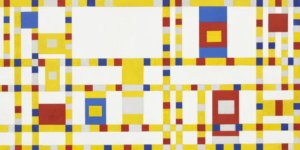In November 2017, the Louvre Abu Dhabi envisioned as a ‘museum city in the sea’ finally opened its doors. Hailed by French President Emmanuel Macron as a “decisive turning point” in ties with the United Arab Emirates, the museum is a partnership between France and UAE that took 10 years to bring to fruition.
Plans for the museum were first announced in 2007 after the Louvre Museum in Paris signed a $525 million agreement allowing the Abu Dhabi government to use the “Louvre” name for its new museum for 30 years. The deal included temporary exhibitions for 15 years and artworks for 10 years. Another $750 million would go to ongoing management advice and assistance and 300 loaned works of art.
See Humanity In A New Rain of Light
However, the opening date kept getting pushed; not once or twice, but again and again over the last decade. Construction works at Louvre Abu Dhabi would start on May 26, 2009, almost 2 years since the museum was approved by the French parliament.
Using the most advanced construction techniques available, work on the site started with the excavation of 17.8 million cubic feet of sand. For six years, 66,000 gallons of water was pumped out of the excavations each hour, every day. At completion, the museum is approximately 78,700 square feet in size, with 26,300 square feet of galleries, establishing itself as the largest museum in the Arabian Peninsula.
The museum itself is an engineering and architectural work of art. Responsible for the museum’s design is Pritzker Prize-winning French architect Jean Nouvel who describes the dome he created as a “rain of light.” The silver-toned dome is constructed of eight layers of interlocking steel and aluminum made up of 85 large steel parts and features 7,850 geometric, star-shaped aluminum inserts. It weighs an astonishing 7,000 tonnes.

Highway Gallery for a Long Road to the Museum
To build awareness and an audience for the museum, the UAE government has taken things up a notch by introducing the “first-ever-in the world-roadside gallery.” Saif Ghobash, the Director General Department of Culture and Tourism – Abu Dhabi (DCT) explains the concept: “you’re on the highway for about an hour and a half, and we have a lot of art here, and so we brought the art to you on the road. You can see a piece and listen to a nicely curated explanation of it. It’s entertaining and educating for the driver, and for the children if they’re in the car.”
The Highway Gallery shows artwork from Louvre Abu Dhabi on billboards that are placed along the highway in 6.2-mile intervals. When cars pass the trigger device 5-6 feet before the billboard and are tuned to any of the three radio stations partnered with the campaign, a short blurb on the artwork plays on the airwaves.

Featuring Old Masterpieces in A New Light
Louvre Abu Dhabi Museum will showcase hundreds of works of art loaned from France which collectively cost $810 million. Loans come from French museums such as Musée Rodin, Château Versailles, Musée d’Orsay, and Pompidou. On display are 235 pieces from the museum’s own collection. These works of art include Van Gogh, Picasso, Monet and Degas, and they are all guarded by Emirati forces who have put in place strict measures to protect the art from the heat. UAE summer temperatures have been to soar well above 104 degrees Fahrenheit.
Remember the confusion behind who really bought Salvator Mundi (Savior of the World) by Leonardo da Vinci that is now considered the most expensive painting ever sold at auction? We now know that it was sold for $450 million at auction by Christie’s in New York to Prince Badr bin Abdullah bin Mohammed Al Farhan on behalf of the Abu Dhabi Department of Culture & Tourism.
Now on display at the Louvre Abu Dhabi, is the highest prized cultural icon that any museum can dream of —a devotional equivalent to the Louvre’s Mona Lisa,the portrait of Jesus as the “Savior of the World.” He is holding one hand up in divine benediction, and the other, the crystal orb, the ideal world. The painting has taken an extraordinarily illustrious journey across continents and finally arrives in the Middle East. How ironic that the ultimate symbol of Christianity sits blessedly in a newly debuted cultural epicenter in the heart of the Arab World.
Might this have been a secret ambition all along of our supreme Renaissance genius?


![[Left] Kusama with her piece Dots Obsession, 2012, via AWARE, [Right] Yayoi Kusama (Courtesy Whitney Museum of American Art) | Source: thecollector.com](https://www.artdex.com/wp-content/uploads/2024/04/Left-Kusama-with-her-piece-Dots-Obsession-2012-via-AWARE-Right-Yayoi-Kusama-Courtesy-Whitney-Museum-of-American-Art-Source-thecollector.com--300x172.png)




